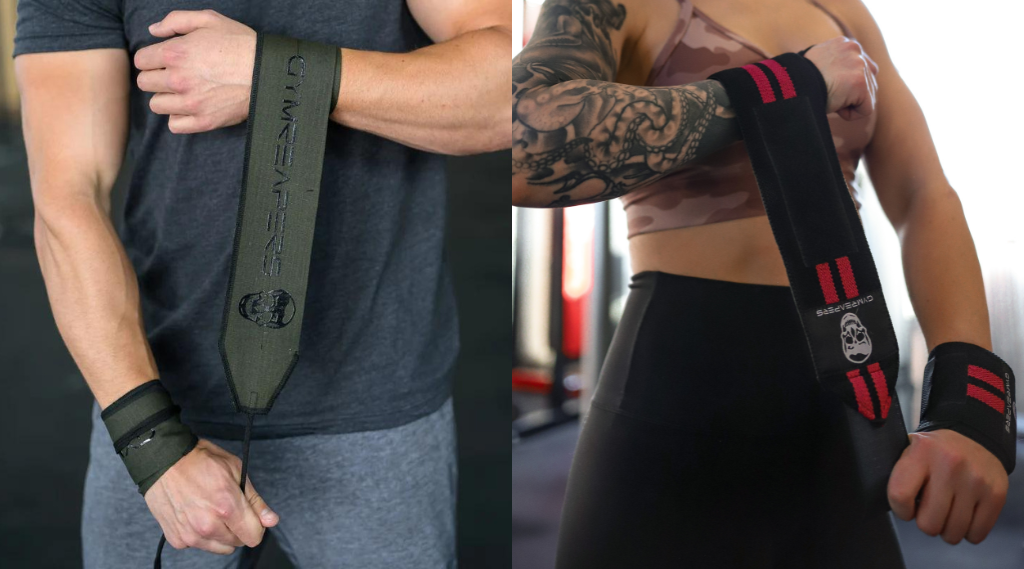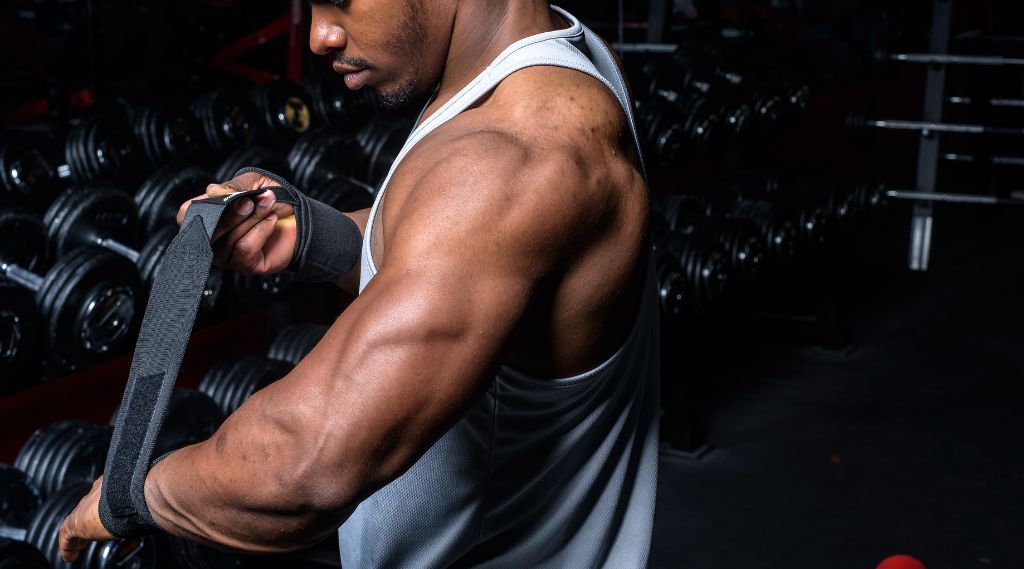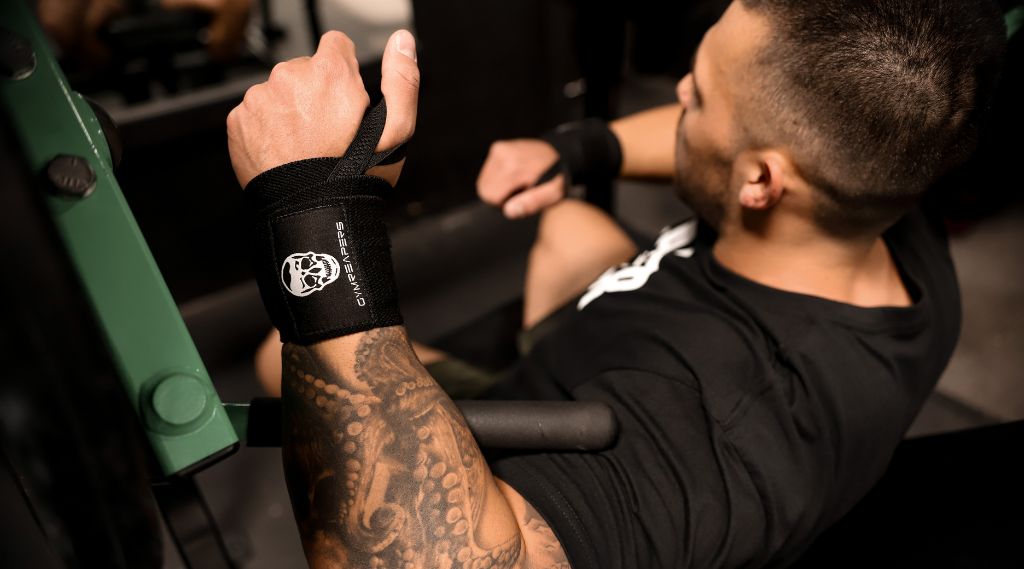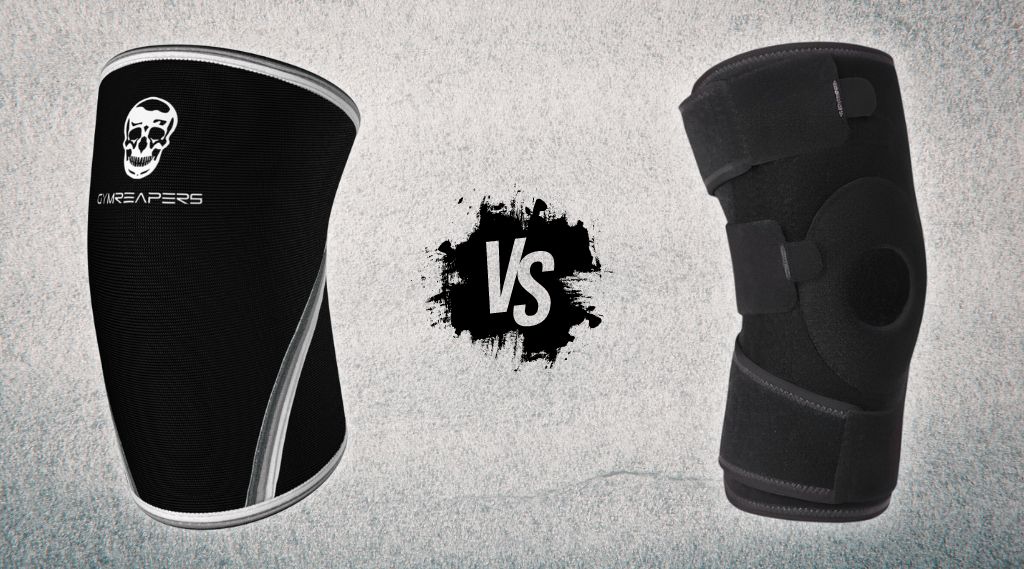If you’re ready to invest in a pair of wrist wraps to keep your wrists strong and stable under heavy loads, you may have noticed that they come in multiple lengths.
Here’s what I tell my clients:
All different lengths of wraps are good for specific situations, and you should choose the length of your wrap based on your wrist size, your preferred type of training, the load on the bar when you are lifting, and your level of experience.
To help you find the right length, I’ll walk you through the pros and cons of each length and how to know which length is right for you.
Key Takeaways
Benefits Of Wrist Wraps

Before we discuss why the right wrist wrap length is important, I’ll quickly outline why you should wear wrist wraps. They provide 3 major benefits to lifters:
1. They Can Help Prevent Injuries
Many people choose to wear wrist wraps during pressing movements, or other heavy lifts like the back squat since they are great at preventing injury.
Their ability to prevent injury stems from the added stability that the wraps give your wrists. This stability decreases your risk of injury since the wrist wrap can support all the muscles and connective tissue around your wrist, hand, and forearm.
Due to this support, there is much less of a chance that your wrist will move involuntarily. This then protects you from strains, or other injuries due to overextending or overworking your wrist muscles.
2. They Help Keep Your Wrists Neutral
A great benefit of wearing wrist wraps for any exercise is the great support that they provide.
When worn properly, wrist wraps can prevent your wrist from bending forward or back and cast your wrist in place.
Since your wrist is cast in place, you have much more stability and rigidity in your hand, wrist, and forearm area. This gives you a much more stable base to lift with.
3. They Can Enhance Your Lifting Performance
Now that we know wrist wraps can help keep you healthy and work to give you a neutral wrist and more stable joint, it makes perfect sense that wraps can help increase your lifting performance.
If you take out risks of injury due to overextending or overworking your small wrist muscles by locking them into a more stable and secure position, you can train your other muscles much harder.
This is because you have taken out the weak link, very similar to how you can deadlift more when you wear straps and take out your grip as a limiting factor.
This benefit is backed by research, which states that in addition to providing a more stable base to lift from, wrist wraps can help you generate more power and force when lifting weights due to the reduced energy leak coming from wrist instability and movement.
Now that you understand the benefits of wrist wraps generally, the rest of the article will discuss why the right wrist wrap length is important and how you can figure out what exactly will be right for you.
Related Article: 3 Types of Wrist Wraps Explained (Which Are the Best?)
Why The Right Wrist Wrap Length Is Important

Wrist wraps are an incredibly beneficial training tool, regardless of their size and length; however, the benefits that you can reap from wrist wraps can vary based on what length you choose.
An example of how the benefits can vary based upon the length that you choose can be seen when we think about smaller lifters compared with larger ones.
Lifters with larger wrists and forearms will inherently need to choose a longer wrist wrap. We know that the stability and support benefit comes from the number of revolutions a wrap can go around your wrist, so it makes sense that a larger lifter will need a longer wrap than a smaller lifter, so they can get the same amount of benefits.
Inversely, it makes sense to assume that a smaller lifter can get away with a shorter wrap since that wrap will be able to go around their wrist the required 2-4 times to get the right amount of tightness.
On top of this, wrist wrap length is important to think about just from a comfort perspective. Even though a smaller lifter could theoretically benefit more from the longest wrist wrap, since it could wrap around their wrist the most amount of times, this would be incredibly bulky and uncomfortable for them, and would likely impact their ability to perform certain movements.
What Are The Different Lengths Of Wrist Wraps?

Common Wrist Wrap Lengths
Wrist wraps typically vary in length anywhere from 12 inches, all the way up to 36 inches. They usually come in increments in between these two extremes which include 18, 20, and 24 inches.
Gymreapers has a few different options that can help identify the different lengths you may be looking for in wrist wraps:
-
Gymreapers Stiff Wrist Wraps allow you to choose from size options of 12, 18, and 24 inches. These are great wrist wraps for providing stiff, heavy-duty support during strength training.
-
Gymreapers Wrist Wraps - 18” Weightlifting Wrist Support is a more flexible version, is 18 inches, and is ideal for more dynamic movements like weightlifting or bodybuilding.
- Finally, Gymreapers Strength Wrist Wraps - Adjustable Support is 36 inches long and is ideal for CrossFit athletes. They are designed to eliminate the need for bulkier training wraps and can be quickly adjusted to different levels of compressing.
Pros and Cons of Shorter Wraps (12-18 inches)
Pros
-
Quick to put on. Shorter wraps mean that they require fewer revolutions around your wrist, which means that they are much quicker to put on. Shorter wraps are more convenient when you’re working out with shorter rest times between sets.
-
Less bulky. Depending on your type of workout, you may not want a lot of bulk on your wrist. If a bulky wrap will interfere with your performance, or you have smaller wrists that can’t hold as much fabric, shorter wraps are the way to go.
- Easier to transport. Shorter wraps are much easier to roll back up and place in your gym bag. They take up much less space and are easier to bring with you.
Cons
- Less support. The major drawback of shorter wraps is the fact that they offer less support. Support mainly comes from the revolutions around your wrist, so they will inherently give you less stability.
This can be mitigated by getting stiffer wraps, or you may be fine if you have small wrists that the wraps can revolve around sufficiently.
This length of wrap is not very functional for many strength athletes, so I would not recommend it for most competitive powerlifters, strongmen, or olympic lifters.
- Doesn’t fit larger wrists. If you have larger wrists and forearms, this length of wrap will likely not fit you. I do not recommend a wrap that you can’t wrap at least 3 times around your wrist, especially if you are lifting heavier loads.
Pros and Cons of Medium Wraps (18-24 inches)
Pros
-
Most likely to fit. These wraps are the most likely to fit the vast majority of people looking to buy wrist wraps. Most lifters choose this range of wraps to start and usually do not feel the need to upgrade to a longer version.
-
Nice blend of comfort and support. 18-24 inch wraps give you the best of both worlds when it comes to comfort and support. They will provide you with more than enough support and will not be too bulky on your wrist (unless you have small wrists).
- Most widely available. Most brands offer at least one model of wrap in this length because it is the most popular length among athletes. This means that you will likely get to choose any brand of wrap you prefer, and may have more options when it comes to features like materials or colors.
Cons
-
Could be too long or short, depending on your wrist. If you have abnormally large or small wrists and forearms, this length of wrap may not fit the way you need it to. I recommend checking reviews and sizing charts before purchasing.
- Too general. If you need wrist wraps for a sport like Crossfit which has a variety of movements, then these wraps may be too general to meet your needs. You may need wraps that are more specific to the movements you plan to use them for.
Pros and Cons of Longer Wraps (24+ inches)
Pros
- Maximum Support. Since more revolutions around your wrist mean that you will have more support and stability, longer wraps will provide you with much more support than shorter wraps.
This is ideal for more competitive strength sport athletes who are lifting heavier loads and may value a more cast-like wrap.
- Durability. Typically, longer wraps last for longer periods because they are not pulled as tightly as shorter wraps.
You still want to tighten your wrist wraps, regardless of length, to gain effective compression, but longer wraps do not require as much effort to tighten as shorter wraps and therefore typically win out in longevity comparisons.
Cons
-
Cumbersome. Longer wrist wraps take a very long time to wrap and unwrap, and the overall bulk of the material can make them a pain to carry around.
- Overkill for most. In my opinion, wraps longer than 24 inches are overkill for most athletes. They may be appropriate if you are an incredibly strong squatter or bench presser and lifting heavy loads more frequently.
However, for most people’s daily training, these wraps are unnecessarily supportive and may be so bulky to the point that they are impeding performance and defeating the purpose of the wrap.
How Do You Know What Length Of Wrist Wraps To Get?

The right length of wrist wrap will depend on 4 factors:
1. The Size Of Your Wrist
As a general rule of thumb, the bigger your hand/wrist/forearm is, the longer your wrap should be. Unfortunately, most manufacturers do not have sizing charts on their websites the same way they do for lifting belts or shoes.
For this reason, you may have to rely on a more subjective interpretation. Read some comments, try on your friends' wraps to see how different lengths fit and feel, and then make your best guess.
Typically, you know if you have large wrists or not in your daily life; however, if you are unsure, I would recommend opting for something in the medium size range of 18-24 inches.
2. Your Preferred Type Of Training
Another key consideration when deciding on the length of your wrist wrap should be your preferred type of training.
While 18-24 inch wraps are the norm for most and will provide great support for your activities in the gym, your style of training may influence you outside of this range.
For instance, powerlifters looking to optimize their bench press and squat under incredibly heavy loads may look for maximum stability and gravitate towards a 36-inch wrap.
On the other hand, a smaller female crossfitter who values adaptability, and speed, and prefers some mobility rather than a cast-like fit, may prefer a smaller 12-inch wrap.
3. Your Level Of Experience
In addition to your wrist size and preferred style of training, you need to judge your level of experience when assessing your wrist wrap needs.
Typically, the more experience you have, the heavier you will be lifting. As such, you may eventually need to change from the length that you were using initially as you progress.
It’s important to ensure that your supportive gear is effectively meeting your current needs for stability and stiffness. Sometimes a shorter wrap that worked perfectly when you were bench pressing 100 lbs less is no longer sufficient to keep you safe and in an optimal position now that you’re stronger.
4. How Much Weight You’re Lifting
Lastly, you need to take into account how much weight is on the bar in your training sessions when choosing between wrap lengths.
If you’re in a phase of training where you’re working on your technique and the loads are lighter, then you may prefer to use a shorter wrist wrap because you won’t need as much support and stability.
If you’re in a phase of training where you’re lifting maximal loads in the 1-3 rep ranges for movements that put your wrists under stress (squat, bench, overhead press), then you may prefer a longer wrap which provides more support and stability.
More Tips For Choosing The Right Wrist Wraps

A few other considerations for choosing the best wrist wraps are:
Stiff vs Flexible
Similar to the length of your wrist wraps, you can get more or less support out of your wraps depending on if they are stiff or flexible.
If you need a shorter wrist wrap because you have smaller wrists but you still want maximum support then choosing a stiff wrist wrap would be best.
If you need a longer wrist wrap because you have larger wrists but you still want to have some mobility at the wrist when performing movements, then choosing a flexible wrist wrap would be best.
For more information on how to decide between choosing a stiff or a flexible wrist wrap, check out “Should Wrist Wraps Be Stiff or Flexible?"
Warranty
A final consideration you may find important is whether or not a wrist wrap has a warranty. This is something that should be available on all retailer’s websites and can help inform your choices as a consumer.
As an example, Gymreapers provides a 1-year warranty for their wrist wraps which allows you to return them for a complete replacement in the event you experience any type of manufacturing defect on any item.
FAQ
What is the best length wrist wrap for powerlifting?
Most powerlifters prefer wrist wraps that are 18-24 inches. These wraps are ideal for squatting and pressing movements and will fit most lifters’ wrists perfectly. However, if you have very large wrists and forearms, and are lifting very heavy absolute loads, I would recommend sizing up to a 36-inch length.
What is the best length wrist wrap for Crossfit?
Most CrossFit athletes prefer wrist wraps that range from 12-18 inches. This length of wrap suits most wrist sizes and is not incredibly bulky, but you may want to size up to a flexible 24-36 inch wrap if you are a larger person or you prefer wraps that give more support and stability.
Are longer wrist wraps better?
Longer wrist wraps typically provide more support and tension, as they can wrap more revolutions around your wrist. These are ideal for larger people, powerlifters lifting heavy loads, or those that want their wraps to be very secure and provide a cast-like effect on their wrists.













Leave a comment
All comments are moderated before being published.
This site is protected by hCaptcha and the hCaptcha Privacy Policy and Terms of Service apply.